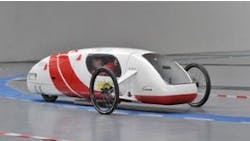Electric vehicle with a wireless twist
Students of the Karlsruhe University of Applied Sciences recently designed an EV called the E-Quickie whose claim to fame is that it gets its energy from electric conducting paths on the ground. Receivers underneath the car take energy from the tracks through electric induction, directing it onward to the car’s electrical hub drive.
The principle is not unlike that used with AGVs, except that the E-Quicky gets its power, not just its directional instructions, via the tracks below it. Individual vehicle components (e.g. steering and braking system, chassis), use high-tech materials. The outer skin of the vehicle’s body is carbon.The entire vehicle weighs 60 kg and it looks as though 40 kg might be possible through further optimization. In May, students took part in a race wherein the car completed 40 laps on the 222-m conductor track.
The car also carries small batteries for power when the car is not over its power-carrying tracks. “We went to the start with half-filled batteries and returned with full ones,” says the project director. Batteries power the car when it leaves the track and to go, say, to the garage.
The motor only has a horsepower of 2 kW and still the vehicle reaches a speed of 50 km/hr.
More info: http://www.hs-karlsruhe.de/servlet/PB/menu/1020752_l1/index.html?pbanker=car#car
